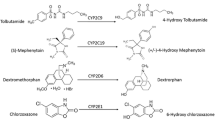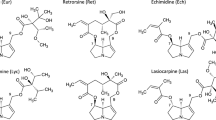Abstract
CYP2D-related drug metabolism in liver microsomes from animals of the Canoidea super family, i.e. mink (Mustela vison), bears (Ursus arctos), foxes (Vulpes vulpes) and dogs, were investigated. Propranolol, bunitrolol and imipramine, which are typically substrates of CYP2D subfamilies, were used in the experiment. All the animals of the Canoidea superfamily that were tested lacked the ability to catalyse 7-hydroxylation of propranolol, which is one of the major metabolic pathways in rats. Stereoselectivity of propranolol metabolism was towards (S)-propranolol in all the reactions of the animals tested with the exception of mink, which showed a selective tendency towards (R)-propranolol in {N-}dealkylation. As far as metabolic patterns of (R)- and (S)-propranolol are concerned, bears, foxes and dogs are alike, but minks are somewhat different. Liver microsomes from mink showed, among the animals of the Canoidea superfamily, the lowest propranolol hydroxylase activity at 4- and 5-positions and imipramine 2-hydroxylation and {N-}demethylation activities. We could not detect bunitrolol 4-hydroxylation in mink liver microsomes at the low substrate concentration used. We conclude that mink have the lowest activity of CYP2D-related xenobiotic metabolism among the Canoidea superfamily.
Similar content being viewed by others
Abbreviations
- CYP:
-
cytochrome P450
- HPLC:
-
high-performance liquid chromatography
- NADPH:
-
nicotinamide–adenine dinucleotide phosphate reduced form
References
Fujita, S., Umeda, S., Funae, Y., Imaoka, S., Abe, H., Ishida, R., Adachi, T., Masuda, M., Kazusaka, A. and Suzuki, T., 1993. Regio- and stereoselective propranolol metabolism by 15 forms of purified cytochrome P450 from rat liver. Journal of Pharmacology and Experimental Therapeutics, 264, 226–233
Guttendorf, R.J., Kostenbauder, H.B. and Wedlund, P.J., 1991. Stereoselective differences in propranolol disposition in female Sprague–Dawley and Dark Agouti rats. Drug Metabolism and Disposition, 19, 251–256
Lowry, O.H., Rosebrough, N.J., Farr, L. and Randall, R.J., 1951. Protein measurement with the folin phenol reagent. Journal of Biological Chemistry, 193, 265–275
Masubuchi, Y., Hosokawa, S., Horie, T., Suzuki, T., Ohmori, S., Kitada, M. and Narimatsu, S., 1994. Cytochrome P450 isozymes involved in propranolol metabolism in human liver microsomes. The role of CYP2D6 as ring-hydroxylase and CYP1A2 as N-desisopropylase. Drug Metabolism and Disposition, 22, 909–915
Nakamura, A., Yamamoto, Y., Tasaki, T., Sugimoto, C., Masuda, M., Kazusaka, A. and Fujita, S., 1995a. Purification and characterization of a dog cytochrome P450 isozyme belonging to the CYP2D subfamily and development of its antipeptide antibody. Drug Metabolism and Disposition, 23, 1268–1273
Omura, T. and Sato, R., 1964. The carbon monoxide binding pigment of liver microsomes. I. Evidence for its hemoprotein nature. Journal of Biological Chemistry, 239, 2370–2385
Silber, B. and Riegelman, S., 1980. Stereospecific assay for −- and +-propranolol in human and dog plasma. Journal of Pharmacology and Experimental Therapeutics, 215, 643–648
Suzuki, T., Narimatsu, S., Fujita, S., Masubuchi, Y., Umeda, S., Imaoka, S. and Funae, Y, 1992. Purification and characterization of a cytochrome P-450 isozyme catalyzing bunitrolol 4-hydroxylation in liver microsomes of male rats. Drug Metabolism and Disposition, 20, 367–373
Tasaki, T., Iwata, H., Kazusaka, A. and Fujita, S., 1998. Regio- and stereoselectivity in propranolol metabolism by dog liver microsomes and the expressed dog CYP2D15. Journal of Biochemistry (Tokyo), 123, 747–751
Walle., T. and Walle, U.K., 1979. Stereoselective oral bioavailability of +/−-propranolol in the dog. A GC-MS study using a stable isotope technique. Research Communications in Chemical Pathology and Pharmacology, 23, 453–464
Author information
Authors and Affiliations
Corresponding author
Rights and permissions
About this article
Cite this article
Ishizuka, M., Lee, J.J., Masuda, M. et al. CYP2D-related Metabolism in Animals of the Canoidea Superfamily – Species Differences. Vet Res Commun 30, 505–512 (2006). https://doi.org/10.1007/s11259-006-3213-8
Accepted:
Issue Date:
DOI: https://doi.org/10.1007/s11259-006-3213-8




